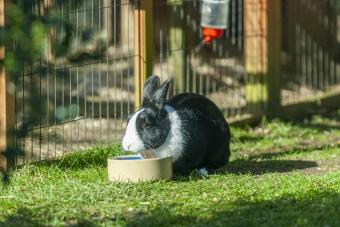
French Angora rabbits are one of the larger breeds of angora rabbits. They differ from the other breeds in size and placement of their wool, as well as in their lower-maintenance coats. Once grouped together with English Angora rabbits and known simply as "Angora Wooler," the French Angora rabbit has long been considered its own breed.
The Origin of the French Angora Rabbit
Prior to 1939, any rabbit capable of growing and producing a wool coat suitable for harvest was classified by the American Rabbit Breeders Association (ARBA) as an Angora Wooler. In 1939, differences and variations in the breed led to the breakdown of the breed into two categories: English Type and French Type. In 1944, ARBA officially declared the two types to be two separate rabbit breeds: the English Angora and the French Angora rabbit.
Physical Characteristics of the French Angora Bunny Breed
French Angoras are the second largest of the ARBA recognized Angora rabbits. They weigh between 7-1/2 and 10-1/2 pounds, with 8-1/2 pounds being the ideal weight.
Wool Coat

French Angoras have two coats of hair: a coarse guard hair, which extends past the undercoat, and a thick, crimped wool coat. The wool may grow as long as six inches but should be a minimum of two inches long. Unlike the English Angora, which has thick wool covering its face, ears, and feet, the French Angora's wool is confined largely to its body. The face and front feet from toes to ankles are clean of wool. The ears and hind legs may have some wool tufts, but this is discouraged amongst shown animals.
French Angora Colors
French Angoras come in all colors, including white, solid, and broken. The color of the rabbit is determined by the color of their head, feet, and tail, which should all be the same color. The toes of the rabbit should all be the same color: white for white rabbits or colored for colored rabbits.
Shape
The French Angora rabbit was originally bred for two purposes: wool and meat. Therefore, the body of the rabbit should be oval-shaped, firm, and strong. The head should also be oval-shaped and in proportion to the body.
Temperament of the French Angora Rabbit
French Angoras are typically mellow and gentle. Like other rabbits, the more they are handled, the more likely they are to become friendlier and more even-tempered. The regular grooming and fur maintenance required, as well as the harvesting of the wool, help to make the French Angora a sweet and gentle rabbit.
These rabbits are highly intelligent and can be trained with enough patience and perseverance. Some keepers train their French Angoras to use a litterbox, whereas others may teach them tricks. Training can certainly come in handy when it comes to grooming tasks.
Care and Maintenance of Your Angora Rabbits
While French Angoras are not as high maintenance as some other Angora breeds, they do require frequent grooming as well as harvesting of their wool two to three times a year. Typical maintenance and care of the French Angora includes:
- Regular blowing of their fur with a blower designed to separate and clean the strands of hair
- Brushing with a slicker brush on an as-needed basis to prevent mats or clumps in the fur
- Clipping the toenails twice a month to prevent overgrowth
- Clipping the wool two to three times a year
French Angora Rabbit Diet
Feed them a mixture of hay and pellets that are between 12 and 18 percent protein. Fiber is also an important for these pets. Feed a diet with at least 18 percent fiber to help prevent wool block, a condition that comes from a buildup of excess hair in the intestine. French Angora rabbits should be fed based on their age:
- Young rabbits between 3 and 7 months of age can eat as many pellets and as much alfalfa hay as they like. One type of vegetable a day can be added to their diet, as well.
- Rabbits 7 months to 1 year of age should be switched over to timothy hay from alfalfa, and they can have it in unlimited amounts. Pellets should no longer be unlimited but instead fed at a rate of 1/2 cup per 6 pounds of body weight. Vegetables can be fed at up to 2 cups per 6 pounds of weight, and 1 to 2 ounces of fruit can be fed one or two times a week.
- Rabbits between 1 and 6 years should receive unlimited hay and 1/4 cup of pellets and two cups of vegetables per 6 pounds of weight daily. Fruit can be given up to twice a week in small amounts, no larger than 2 ounces.
- Rabbits 6 years or older can follow the same diet as an adult rabbit as long as they remain healthy. If you see them starting to lose weight, you can increase their daily amount of pellets and add in alfalfa until they begin maintaining a normal, healthy weight.
French Angora Rabbit Health Concerns
French Angora rabbits have an average lifespan of 7 to 12 years. They can be kept indoors or outdoors and do not require vaccinations. The biggest health concern that a French Angora rabbit faces is wool block. To help prevent this, make sure your rabbit has access to plenty of hay or high-fiber pellets as well as plenty of water. Signs of wool block include:
- Loss of appetite
- Loss of thirst
- Small, dry and more infrequent feces
- Lack of urination
- Lethargy
If you notice signs of wool block, consult your veterinarian immediately.
Showing, Breeding, and Wool Producing Rabbits
If you are interested in acquiring a rabbit for showing, breeding, or wool-producing purposes, the French Angora breed is ideal for all three. Their gentle temperament combined with the lower-maintenance coat make this breed one that many people can handle.







